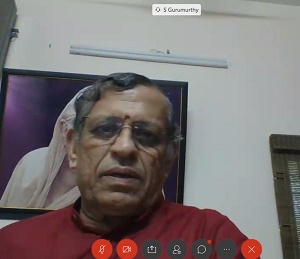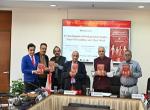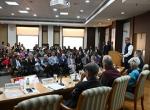On 6th August 2020 VIF organised a symposium on the theme: “The Arthasastra: New Directions in Research”. The aim of the symposium, apart from briefly discussing the historical perspectives on the Arthasastra, was to shed light on the strategic use and relevance of the text for governance today and the way ahead in promoting research on the Arthasastra. The panellists included Professor Rupendra Kumar Chattopadhyay, Vivekananda Chair Professor of Social Science, University of Calcutta, Dr Arpita Mitra, Research Fellow, VIF, Dr Kajari Kamal, faculty for the postgraduate programme in Strategic Studies at Takshashila Institution, Dr Saurabh Mishra, Assistant Professor, Amity Institute for Defence & Strategic Studies, Dr Medha Bisht, Assistant Professor, Department of International Relations, South Asian University, and Colonel Pradeep Kumar Gautam (Retired), Honorary Distinguished Fellow at the Centre for Armed Forces Historical Research, United Service Institution of India (USI).Dr Arvind Gupta, Director VIF, made introductory remarks on the importance of the symposium and welcomed the panellists.
The first session of the symposium was based on historical perspectives and historical trends in the study of Arthasastra. While outlining the historiography on Arthasastra, Prof. RK Chattopadhyay made mention of scholarly works about the Arthashastra as a text. In this regard, he discussed the works of Rudrapatna Shamasastry, RP Kangle, Julius Jolly, PV Kane and DD Kosambi. He then focused on the scholarly works of EH Johnston, Moreshwar Dikshit, UN Ghoshal, Aradhana Parmar, Suvira Jaiswal, Josia James and EJ James and Sanjeev Kumar Sharma, who used Arthasastra as a source to interpret the different dimensions of historical thoughts as well as social dynamics (political, religious, economic, administrative and so on). Further, he deliberated on the debates of the date of the writing of the Arthasastra. He mentioned that there have been a fair number of scholars who over the years have contributed to the debate on the date of the text. In 1929, Johnston published an article called Two Studies in the Arthasastra of Kautilya, where he attempted to consider the relationship between the date of the Arthasastra and the works of Asvaghotato Aryasura's Jatahamala and the Lanhdvatdrasutra.
Similarly, in the 1964 article The Date of Arthasastra, IW Mabbett discussed at length the various views regarding the date of the text's composition. DR Bhandarkar, J. Duncan M. Derett, Ludwig Setback, Thomas Trautmann, all have been major contributors to this debate.

Prof Chattopadhyay stressed that it is with the works of Patrick Olivelle that this debate has attained new heights. In his new annotated translation of the Arthasastra, Olivelle states that the surviving manuscripts of the Arthasastra are the product of a transmission that has involved at least three major overlapping divisions or layers. The Arthasastra as we receive it, he argues, has its roots in textual materials dating somewhere between the mid-first century BCE and the mid-first century CE. These materials are lost and we only know of their existence because of references to them in the later literature. Thus, Prof. Chattopadhyay states that Olivelle settles many questions about the date, authorship, architecture, and contents of the text that have afflicted scholars since the first modern edition of 1909.
Furthermore, Dr Arpita Mitra explored the crucial elements of Mark McClish’s The History of the Arthasastra: Sovereignty and Sacred Law in Ancient India, while discussing the textual history of the Arthasastra. She states that McClish has attempted a reconstruction of the history of the text. He employs the method of text-critical or text-historical or historical-critical (goes by different names) analysis to rigorously perform a twofold task: first, backtrack the possible textual redaction to unfold the story of the making of Arthasastra; second, in the light of this story, allot a chronological context to the ideological content of Arthasastra. McClish begins by illustrating how the use of chapter colophons, end verses, and citations confirm that Kautilya’s Arthasastra is a redacted version of a preceding text, ‘Dandaniti’. Thus, he maintains that Kautilya was not a composer but a redactor. He further, argues that the composer and the redactor of Arthasastra was not the same person. Denying the traditional account which ties the textual history of Arthasastra to the imperial Mauryan period of the fourth century BCE, McClish emphasizes that the non-redacted text of ‘Dandaniti’ was not imperial; in fact, ‘Dandaniti’ existed around second century BCE. It was only during the post-Mauryan Gupta period from 4th to 6th century BCE, that the unitary authorship of Arthasastra was conferred upon Kautilya or Chanakya, thereby leaving an impression that Kautilya and Chanakya were identical.
Dr Mitra highlighted that McClish departs from the existing historiography of Arthasastra in three ways, first, he gives a new history of the text, second he does not agree with previous scholars regarding its authorship, third, he is giving a new date to the text. Dr Mitra then critiques McClish on these assumptions. She underscores that in fact, all major scholars on Arthasastra have accepted unitary authorship of the text. She alludes to RP Kangle’s outlook whereby he accepts the disjunctions within the text but maintains that they aren’t as glaring as to point out multiple authorships. Additionally, Dr Mitra assesses McClish's methodology of the historical-critical method, which she critiques as being a highly subjective method and also one which reconstructs the history of text using philological or linguistic criteria. It is within these linguistic features of citations, colophons, etc where he discovers an organisational plan or pattern. Thus, the major criticism of the method employed is that it is purely conjectural. The existence of a pattern doesn't unequivocally point towards a conclusion. She concluded with the observation that she is uncomfortable with McClish's translation of ‘dharma’ as ‘sacred law’. ‘Law’ is one of the many meanings of ‘dharma’ and the concept also has a sacred origin, but to translate the word as ‘sacred law’ in a world that is dominated by the sacred-secular divide can lead to misunderstandings and theoretical problems.
The second session of the symposium was based on ‘Strategic Perspectives’ on the Arthasastra. Dr Kajari Kamal revisited the strategic cultural debate on Arthasastra. She began by underpinning the importance of Kautilya's Arthasastra and the extent to which it has lent itself to the framing India's strategic culture. She accentuated that the Indian strategic community is the latent repository of the ‘Kautilyan idea contents’. She extrapolated from the works of Subrata K. Mitra and Michael Liebig, Kautilya’s Arthasastra: an Intellectual Portrait: the Classical Roots of Modern Politics in India and ascertained that the text is dominated with the ideational strand and continuities of ‘Kautilyan Realism’. Moreover, the work showcases the endogenous politico-strategic thought that underpins India’s rise in the 21st century. The political institutions and processes in contemporary India remain deeply grounded in its pre-modern political heritage and are succinctly codified in Kautilya’s Arthasastra. These themes are explored through such bridge concepts as the ‘modernity of tradition’ and the ‘re-use of the past’ in tackling contemporary political problems. She claims that these concepts are key factors that explain the resilience and stability of India’s hybrid political institutions and democratic system as well as its foreign policy conduct. She further described Alastair Iain Johnston methodological framework, to identify Kautilya’s Arthasastra as the ‘formative’ ideational strategic text to assess Indian strategic culture. Arthasastra, she stresses, is a text representative of the formative period in the development of Indian strategic thought, and is compatible through the lens of ‘object of analysis’. However, she remarked that the utility of strategic culture can be proven only when it is shown to have a substantial effect on strategic behaviour. The grand strategic choices of a nation’s decision-making elite should be consistent with the behaviour predicted by the strategic-culturally derived preference ranking. Her proposed last step of the research process is to assess India’s foreign/security policy in the light of the Kautilyan underpinnings of Indian strategic culture.
Next, Dr Saurabh Mishra reviewed the work of Dr Medha Bisht, titled Kautilya’s Arthasastra: Philosophy of Strategy, to establish the Arthasastra as a key text in the quest for the roots of Indian strategic culture. He asserted that Dr Bisht’s work is based on a philosophical approach to the question. Adopting a hermeneutic approach, her work discusses certain homologies related to concepts such as power, order, and morality. She underlines the conceptual value of the Arthasastra and classical texts such as Hitopdesha and Pancatantra. It shows how comparative analysis of these texts reveals continuity rather than a change in the styles, tactics and political strategies. He said that she highlights Kautilya as a coherent political-strategic thinker. She seeks to emancipate concepts familiar to non-western space and therefore her work is not an attempt to create alternative theories of the world. It highlights the non-western perspectives related to diplomacy and statecraft. Finally, he concludes that the acknowledgement of non-western philosophy and tradition to the world politics’ theories are of utmost importance.
Later, Dr Medha Bisht discussed Dr Deepshikha Shahi’s, Kautilya and Non-Western IR Theory. She pointed out that the International Relations and political theory scholarship today is mainly constructed by the narratives of western civilization. From the Greeks to the biopolitics of Foucault, the theories we reverentially study are confined to the discourse coming from one civilizational root, which curtails the ability of scholars to appreciate the founding principles of statecraft and diplomacy practised in non-western civilizations. Thus, she maintains that Kautilya and Non-western IR Theory is a welcome addition to the literature. She adds that Dr Shahi’s interpretation of Arthasastra reconciles ‘rationalist’ thinking with ‘reflectivist’ thinking. Through this, Dr Shahi positions herself in the great debate in IR. She bridges the gap between the rationalist and realist debate on Arthasastra within the discipline of IR. However, Dr Medha Bisht flagged an important caveat in the textual analysis of Dr Shahi. She pointed out that the metatheoretical understanding of Arthasastra would be well placed with critical theory and urges to look at Arthasastra in a network and holistic manner. Binding it to a particular approach paradigm does injustice to this classic text.
Then, Colonel PK Gautum spoke about the limitations in the scholarly works on Arthasastra. He claims that the non-western scholarship has been unable to associate and relate Arthasastra with contemporary times. He stipulates that Kautilya’s Arthasastra has to be viewed beyond the predilection of ‘yogakshema’. To make Kautilya’s Arthasastra relevant, scholarly attempts to study the text and then critically apply it to explain, compare and understand contemporary issues are a must. But in doing so, one should avoid ‘presentism’. In the policy recommendations, he argued that more applicatory and interpretative work needs to be done on themes such as foreign policy, intelligence, war and internal security as it relates to contemporary times.
Eventually, Shri S Gurumurthy, Chairman VIF, in his concluding remarks illuminated the significance of Indian philosophy. He postulated that vis-à-vis Western philosophical thought, Indian philosophy offers both surprising points of affinity and illuminating differences. The differences highlight certain fundamentally new questions that the Indian philosophers have asked. The similarities reveal that, even when philosophers in India and the West were grappling with the same problems and sometimes even suggesting similar theories, Indian thinkers were advancing novel formulations and argumentations. Indian approach, therefore, cannot be studied in isolation and a multi-disciplinary study of how strategic study has evolved in India is needed. Indian scholars should not confine themselves to interpretation or periodicity or dating of Arthasastra. Simultaneously, it is important to integrate the Indian view of ‘VasudhaivaKutumbakam’ which is an antidote to contemporary strategic thinking, ridden with war and abject violence.







Post new comment